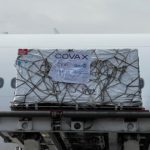An 83 per cent surge in new COVID-19 cases during the past week in Africa, driven by the Delta and the Omicron variants, is causing fewer deaths than previous surges — but more waves could be building as updated forecasts warn that the continent may not reach 70% vaccine coverage until August 2024, a new World Health Organization (WHO) pandemic assessment finds.
Africa recorded more than 196 000 new cases for the week ending on 12 December, up from around 107 000 in the previous week, bringing the total cumulative number of recorded cases during the pandemic to 8.9 million. The number of new COVID-19 cases is currently doubling every five days, the shortest reported this year. While the speed of the spread is fast, deaths remain low and even dropped by 19% last week compared with the previous week.
There were a little over 3000 deaths reported during the first three weeks of the current pandemic wave, which is Africa’s fourth. About half as many cases were reported in the same time frame during the third wave which was fuelled by the Delta variant.
This upsurge in new cases coupled with low hospitalizations is particularly marked in South Africa which has experienced a 66% rise in new cases during the past seven days compared with the previous seven days. While hospitalizations have increased by 67% in the past seven days, the bed occupancy rate for Intensive Care Units remains low at 7.5%, with 14% of the hospitalized patients receiving supplemental oxygen. Though the deaths also remain low, this data should be interpreted with caution as the pattern may change in the coming weeks.
“We are cautiously optimistic that deaths and severe illness will remain low in the current wave, but slow vaccine rollout in Africa means both will be much higher than they should be,” said Dr Matshidiso Moeti, WHO Regional Director for Africa. “We’ve known for quite some time now that new variants like Beta, Delta or Omicron could regularly emerge to spark new outbreaks globally, but vaccine-deprived regions like Africa will be especially vulnerable.”
Vaccination coverage remains highly variable across the region. As of 13 December, only 20 African countries had vaccinated at least 10% of their population, the global target WHO had set for September 2021. Only six countries have hit the year-end target of fully vaccinating 40% of their population, while only two countries Mauritius and Seychelles have reached the 70% coverage seen as essential for controlling the pandemic. At the current pace, WHO estimates that it will take until May of 2022 before Africa reaches 40% coverage and August 2024 before it reaches the 70% mark.
“In a world where Africa has the doses and support to vaccinate 70% of its population by the end of 2021—a level many wealthy countries have achieved—we probably would be seeing tens of thousands of fewer deaths from COVID-19 next year,” Dr Moeti said. “But we can still save many lives if we can accelerate the pace of vaccination in early 2022.”
WHO data show that 53 African countries have initiated vaccination programmes, which have administered a total of 264 million doses (or 61% of doses received). Fully vaccinating 70% of Africans requires about 1.6 billion more doses and strengthened efforts to increase vaccine demand.
“We’re at a pivotal moment in this pandemic where complacency is the enemy,” said Dr Moeti. “With supplies starting to increase we now must intensify our focus on other barriers to vaccination. They include lack of funding, equipment, healthcare workers and cold chain capacity along with tackling vaccine hesitancy.”
WHO is supporting efforts in African countries to complete district “micro plans”, which identify hard-to-reach populations and outline vaccine delivery strategies to reach them.
According to the WHO Africa COVID-19 readiness dashboard, of the 34 countries that have submitted complete data, 28 countries (80%) have engaged provinces and districts in preparations for vaccinations; 32 countries (91%) have conducted national training initiatives; and 29 countries (82%) have trained district vaccinators and volunteers.
To increase vaccination coverage, WHO is encouraging countries to move vaccination sites beyond health facilities and main cities and implement community centred approaches. In an analysis of data collected from 40 countries, six countries confirmed having districts with no vaccination sites.
Meanwhile, Africa’s vaccine challenges are being compounded by Omicron-related travel bans.
Globally, there have been more than 2700 Omicron cases reported in 59 countries, including 11 African countries that account for about 33% of the total cases. However, Africa’s share is steadily dropping, and South Africa no longer leads the world in Omicron cases. Yet more than 70 countries continue to impose travel bans mainly targeting African countries.
“Blanket travel bans have little impact on the course of an epidemic but have a massive socioeconomic effect,” said Dr Moeti. “Coming after two years of COVDI-19, these new travel restrictions are jeopardizing the health of millions of Africans.”
In addition to vaccination coverage, WHO’s 2022 COVID-19 strategy for Africa includes a strong focus on surveillance aimed at increasing case detection, strengthening genomic surveillance to track new variants of concern as well as country capacity for appropriate case management including home-based isolation and care, and guarding against COVID-19 with key preventive measures amidst reduced risk perception.






